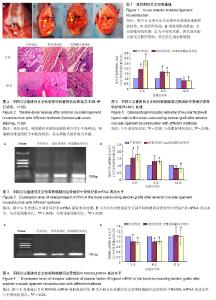| [1] 张承昊,李棋,唐新,等.促进腱-骨愈合方法的研究进展[J].中国修复重建外科杂志,2015,29(7):912-916.[2] 吴平,林石明.前交叉韧带重建术后腱-骨愈合研究进展[J].实用骨科杂志,2014,20(4):326-329.[3] 王辉,王万明.前交叉韧带重建术后腱骨愈合影响因素研究进展[J].实用医学杂志,2014,30(14):2343-2345.[4] 柴昉,蒋佳,陈世益.促进前交叉韧带腱骨愈合的生物治疗技术研究进展[J].中国运动医学杂志,2016,34(4): 327-377.[5] 吴继云,陈伟南,邓亚开,等.自体-异体混编肌腱重建前交叉韧带移植物腱骨愈合的实验研究[J].中国矫形外科杂志,2015,23(24):2283-2288.[6] Muller B, Bowman KF Jr, Bedi A. ACL graft healing and biologics. Clin Sports Med. 2013;32(1):93-109. [7] Zhao S, Peng L, Xie G, et al. Effect of the Interposition of Calcium Phosphate Materials on Tendon-Bone Healing During Repair of Chronic Rotator Cuff Tear. Am J Sports Med. 2014;42(8):1920-1929. [8] Weimin P, Dan L, Yiyong W, et al. Tendon-to-bone healing using an injectable calcium phosphate cement combined with bone xenograft/BMP composite. Biomaterials. 2013;34(38):9926-9936.[9] Chen L, Jiang C, Tiwari SR, et al. TGIF1 Gene Silencing in Tendon-Derived Stem Cells Improves the Tendon-to-Bone Insertion Site Regeneration. Cell Physiol Biochem. 2015;37(6):2101-2114. [10] Würgler-Hauri CC, Dourte LM, Baradet TC, et al. Temporal expression of 8 growth factors in tendon-to-bone healing in a rat supraspinatus model. J Shoulder Elbow Surg. 2007;16(5 Suppl):S198-203. [11] Lyras DN, Kazakos K, Agrogiannis G, et al. Experimental study of tendon healing early phase: is IGF-1 expression influenced by platelet rich plasma gel? Orthop Traumatol Surg Res. 2010;96(4):381-387. [12] Ross D, Maerz T, Kurdziel M, et al. The effect of granulocyte-colony stimulating factor on rotator cuff healing after injury and repair. Clin Orthop Relat Res. 2015;473(5):1655-1664. [13] Tokunaga T, Shukunami C, Okamoto N, et al. FGF-2 Stimulates the Growth of Tenogenic Progenitor Cells to Facilitate the Generation of Tenomodulin-Positive Tenocytes in a Rat Rotator Cuff Healing Model. Am J Sports Med. 2015;43(10):2411-2422. [14] Sun L, Wu B, Tian M, et al. Comparison of graft healing in anterior cruciate ligament reconstruction with and without a preserved remnant in rabbits. Knee. 2013; 20(6):537-544.[15] Li H, Chen J, Chen S. Remnant Repair-enhanced Polyethylene Terepthalate Artificial Ligament Graft Ligamentization. Int J Sports Med. 2015;36(12): 1015-1020. [16] Lee BI, Kwon SW, Choi HS, et al. Anatomic Single-Bundle Anterior Cruciate Ligament Reconstruction With Remnant Preservation Using Outside-In Technique. Arthrosc Tech. 2015;4(4): e331-334. [17] 高加智,孙磊.保留残迹对骨隧道封闭前交叉韧带重建移植物关节内愈合的影响[J].中国矫形外科杂志,2013, 21(18):1877-1881.[18] Lee BI, Min KD, Choi HS, et al. Arthroscopic anterior cruciate ligament reconstruction with the tibial-remnant preserving technique using a hamstring graft. Arthroscopy. 2006;22(3):340.e1-7.[19] Ahn JH, Wang JH, Lee YS, et al. Anterior cruciate ligament reconstruction using remnant preservation and a femoral tensioning technique: clinical and magnetic resonance imaging results. Arthroscopy. 2011;27(8):1079-1089. [20] Song GY, Zhang J, Li X, et al. Biomechanical and Biological Findings Between Acute Anterior Cruciate Ligament Reconstruction With and Without an Augmented Remnant Repair: A Comparative in Vivo Animal Study. Arthroscopy. 2016;32(2):307-319. [21] 邹国耀,宋恩鸿,李张.股骨隧道角度对兔前交叉韧带重建术后骨隧道影响的初步探讨[J].中国修复重建外科杂志, 2015,29(2):171-174.[22] 杨伟毅;陈嘉怡;何於,等.补肾中药对兔前交叉韧带重建术后腱-骨愈合生物力学的影响[J].广东医学,2014,35(13): 2001-2003.[23] 管林聪,邹国耀,唐志宏,等.骨保护素/脱蛋白骨对兔前交叉韧带重建腱-骨早期愈合的影响[J].安徽医科大学学报, 2016,51(6):827-831.[24] 杨军军,徐斌,徐洪港,等.MSCs联合PRP对兔前交叉韧带重建后腱骨愈合的影响[J].安徽医科大学学报,2016, 51(3):368-372.[25] 刘平,敖英芳.兔交叉韧带解剖学及生物力学特性研究[J].中国运动医学杂志,2005,24(3):326-328.[26] 姜文跃,林元问,罗映辉,等.兔前交叉韧带生物力学研究[J].北京生物医学工程,1991(4):242-245.[27] Tomita F, Yasuda K, Mikami S, et al. Comparisons of intraosseous graft healing between the doubled flexor tendon graft and the bone-patellar tendon-bone graft in anterior cruciate ligament reconstruction. Arthroscopy. 2001;17(5):461-476.[28] Weiler A, Hoffmann RF, Bail HJ, et al. Tendon healing in a bone tunnel. Part II: Histologic analysis after biodegradable interference fit fixation in a model of anterior cruciate ligament reconstruction in sheep. Arthroscopy. 2002;18(2):124-135.[29] 肖国庆,李箭.前交叉韧带重建及其腱-骨愈合特点[J].中国组织工程研究与临床康复,2008,12(37):7359-7393.[30] Harada S, Takahashi N. Control of bone resorption by RANKL-RANK system. Clin Calcium. 2011;21(8): 1121-1130.[31] Simonet WS, Lacey DL, Dunstan CR, et al. Osteoprotegerin: a novel secreted protein involved in the regulation of bone density. Cell. 1997;89(2):309-319.[32] Kadri A, Ea HK, Bazille C, et al. Osteoprotegerin inhibits cartilage degradation through an effect on trabecular bone in murine experimental osteoarthritis. Arthritis Rheum. 2008;58(8):2379-2386.[33] 梁青春,徐康,刘江华,等.OPG 基因敲除小鼠骨量及微结构的改变[J].中国现代医学杂志,2011,21(17):1989-1994.[34] Rodeo SA, Kawamura S, Ma CB, et al. The effect of osteoclastic activity on tendon-to-bone healing: an experimental study in rabbits. J Bone Joint Surg Am. 2007;89(10):2250-2259.[35] 魏冰,邹国耀,宋恩鸿,等.不同浓度比例骨保护素与脱蛋白骨凝胶复合物对前交叉韧带重建术后骨隧道影响的实验研究[J].中国修复重建外科杂志,2015, 29(11):1369-1375.[36] 董向辉,凌鸣,冯伟楼,等.关节滑液对兔前交叉韧带重建后腱骨愈合生物力学和组织学的影响[J].中国组织工程研究,2012,16(11):1937-1940.[37] 郭伟.骨保护素在骨相关疾病领域的研究进展[J].中国矫形外科杂志,2013,21(24):2499-2502.[38] Xie GM, Huang Fu XQ, Zhao JZ. The effect of remnant preservation on patterns of gene expression in a rabbit model of anterior cruciate ligament reconstruction. J Surg Res. 2012;176(2):510-516.[39] Sobacchi C, Frattini A, Guerrini MM, et al. Osteoclast- poor human osteopetrosis due to mutations in the gene encoding RANKL. Nat Genet. 2007;39(8):960-962.[40] Ha J, Lee Y, Kim HH. CXCL2 mediates lipopolysaccharide-induced osteoclastogenesis in RANKL-primed precursors. Cytokine. 2011;55(1): 48-55.[41] 王程,徐小龙,袁雪凌,等.人股骨头坏死微观结构及成骨?破骨细胞活性的区域性分布特征[J].中华骨科杂志,2014, 34(4):417-424.[42] Bishop KA, Coy HM, Nerenz RD, et al. Mouse Rankl expression is regulated in T cells by c-Fos through a cluster of distal regulatory enhancers designated the T cell control region. J Biol Chem. 2011;286(23):20880-20891.[43] Kolund?i? R, Trkulja V, Mikolau?i? M, et al. Association of interleukin-6 and transforming growth factor-β1 gene polymorphisms with developmental hip dysplasia and severe adult hip osteoarthritis: a preliminary study. Cytokine. 2011;54(2):125-128.[44] Sethi N, Dai X, Winter CG, et al. Tumor-derived JAGGED1 promotes osteolytic bone metastasis of breast cancer by engaging notch signaling in bone cells. Cancer Cell. 2011;19(2):192-205.[45] Komatsu N, Okamoto K, Sawa S, et al. Pathogenic conversion of Foxp3+ T cells into TH17 cells in autoimmune arthritis. Nat Med. 2014;20(1):62-68.[46] Blanchard F, Duplomb L, Baud'huin M, et al. The dual role of IL-6-type cytokines on bone remodeling and bone tumors. Cytokine Growth Factor Rev. 2009;20(1):19-28.[47] Pacifici R. The immune system and bone. Arch Biochem Biophys. 2010;503(1):41-53.[48] Ominsky MS, Li X, Asuncion FJ, et al. RANKL inhibition with osteoprotegerin increases bone strength by improving cortical and trabecular bone architecture in ovariectomized rats. J Bone Miner Res. 2008;23(5): 672-682.[49] 黄慧,陈健,何剑全,等.巴戟天含药血清对成骨-破骨细胞共育体系OPGmRNA?RANKLmRNA表达的影响[J].中国骨质疏松杂志,2015,21(1):67-71.[50] 曹旭,向文英,陆苑,等.杜仲含药血清对成骨细胞的影响[J].中华中医药杂志,2016,31(8):3016-3019. [51] 徐建明,袁风红,高恺言,等.OPG-RANKL-RANK系统对绝经后女性类风湿关节炎患者骨代谢的影响[J].中国骨质疏松杂志,2016,22(3):261-264.[52] Xu XJ, Shen L, Yang YP, et al. Serum β -Catenin Levels Associated with the Ratio of RANKL/OPG in Patients with Postmenopausal Osteoporosis. Int J Endocrinol. 2013;2013:534352. [53] Wang XF, Zhang YK, Yu ZS, et al. The role of the serum RANKL/OPG ratio in the healing of intertrochanteric fractures in elderly patients. Mol Med Rep. 2013;7(4):1169-1172.[54] Giganti MG, Liuni F, Celi M, et al. Changes in serum levels of TNF-alpha, IL-6, OPG, RANKL and their correlation with radiographic and clinical assessment in fragility fractures and high energy fractures. J Biol Regul Homeost Agents. 2012;26(4):671-680 |

